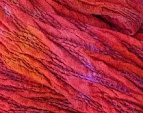I might be wrong but Yoshiko had been teaching on the east coast of Australia for about 3-4 weeks before coming to NZ. We were the last of three workshops here and I think she was exhausted.
Our class started 3 days before the main forum so we didn't have the excitement of other classes going on at the same time and I guess I'm used to attending classes where everyone is a weaver or spinner so have a common bond to start with. I did think we were given a bum stear at the end as the next tutor wanted to set up in our classroom so we were moved to another room. Had hardly finished our windup (before 4pm) when we were turfed out of there so the new lot could have their glass of wine so everyone just scattered. A bit poor as we had paid good dosh to attend and didn't need to be treated like second rate citizens.
Enough moaning! I enjoyed the stitching but it is slow so had to do a lot in the evenings and soak and part dry the samples overnight ready for the indigo bath the next morning, early before the days talk started at 9am. Haven't decided what my favourite would be, perhaps the folding and stitching, katano. Clamping is instant gratification - minimum effort for maximum result was Yoshiko's quote - minimum for maximum. We briefly touched on pole wrapping at the end and the notes give many variations for this so much still to try.
This was an old fushia coloured scarf, folded and clamped and dyed with a square block. This was removed and the circle clamped and a second dip dye.
This was preprinted cotton lawn, the sample on the right looks like pegboard, the left hand sample works very well. Fabric is folded, layers of calico placed on each side and its stitched to resist the dye.
I enjoyed the indigo dyeing, especially as I find it so hard to dye cotton with procion dyes but it seemed very hard to get solid information on looking after the indigo. Yoshiko seemed to instinctively know how to look after it, just how much lime or zinc to add and when from long experience. I wouldn't have the patience for it now.
Having ironed the samples and been through the photography process I think I'm going to give the overall experience of the workshop a 5!





Your workshop samples are lovely! I do agree with you that shifting you out of your classroom was very disruptive and should not have happened.
ReplyDeleteI went to a very pricey workshop held by a master weaver some years ago and close attention was necessary to the lift plan on our table looms (multi shaft shadow weave!) People started wandering in and around the room and asking questions and interrupted my place in the sequence. Not one of my samples is complete or mistake free!
It seems the building where the course was held has an open door policy on all studios for the general public to wander in. The guild got a discount on their rent by agreeing....
It cheeses me off to this day as I paid full price!
:) Susan
So it wasn't just me feeling sorry for myself? That's a relief. I believe we have got to start organizing workshops with overseas tutors where ours take place first and then the Aussies - or at least the tutors have a bit of a break between Oz and us!
ReplyDeleteThank you Susan. There's more I haven't shown just so you don't think that was three days work!
ReplyDeleteYou're right Meg but can you see it happening?
Hi Susan,
ReplyDeleteI love your samples!
I did the workshop in Oz but ours was only 2 days instead of 3. I think it also depends on the class size!?
I felt that our workshop is a bit rushed as well, trying to fit everything into it.
Goodness only 2 days! By the time you settle in thats most of the first morning gone and winding up on the last afternoon. I hope you've tried other techniques since the workshop.
ReplyDeleteA few of us from the workshop are getting together to do a dye day. We are going to try some natural dyes. I have been away but have acquired a couple of tools and a book to help learn more shibori. Will do a post on it soon.
ReplyDelete